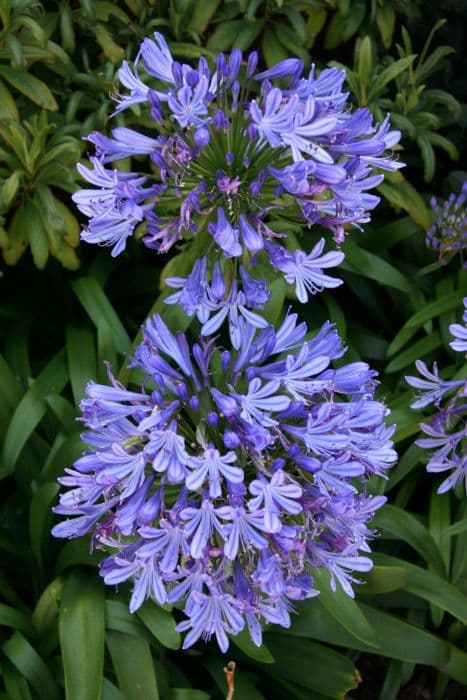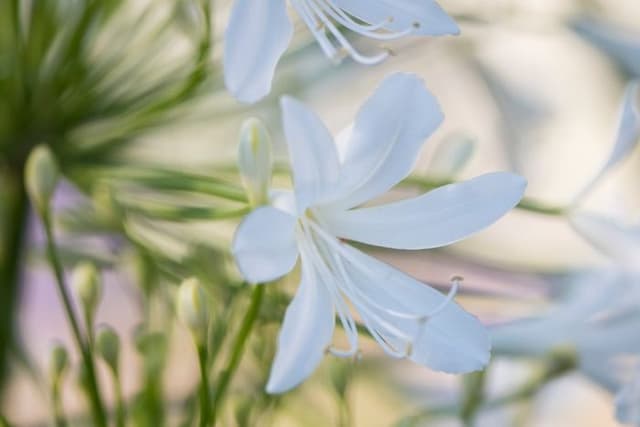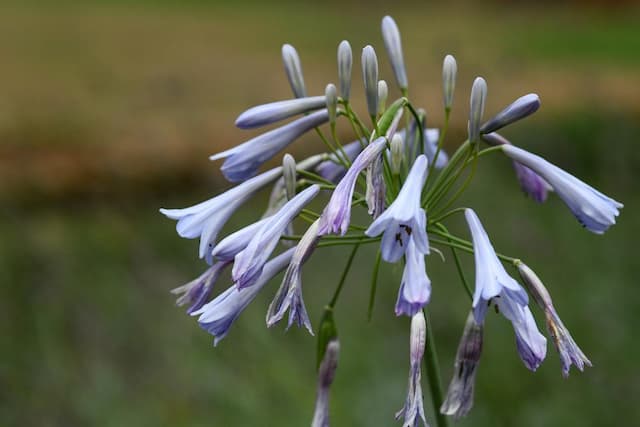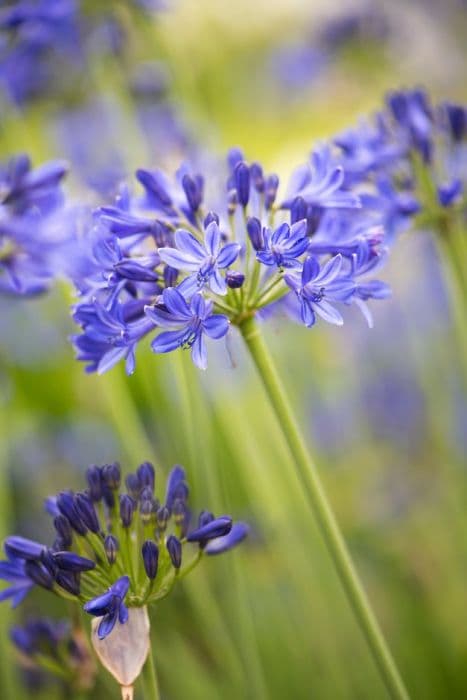African Lily Agapanthus Silver Moon = 'Notfred' (PBR) (v)
![African lily [Silver Moon]](/_next/image?url=https%3A%2F%2Fplants-admin.emdemapps.com%2Fimages%2Fplants%2F%2Fimages%2F604b58964c92e.png&w=3840&q=75)
ABOUT
Agapanthus Silver Moon, also known as 'Notfred', is a distinctive ornamental plant that features striking foliage and floral characteristics. The leaves of Silver Moon are particularly eye-catching, with a variegated pattern. Each leaf exhibits a broad, cream or silver edge that beautifully contrasts with a central green stripe, giving the foliage a lush, bicolored appearance. Come blooming season, the plant produces tall, sturdy flower stalks that bear rounded clusters of flowers. These blossoms are typically a deep blue or violet color, adding a vibrant splash of color to the plant's overall display. Each individual flower is trumpet-shaped, contributing to the elegant and showy nature of the inflorescence. Together, the variegated leaves and the richly colored blooms create an attractive spectacle in any garden space. The Silver Moon variety is not only cherished for its aesthetic qualities but also for its robust nature, making it a popular choice for gardeners looking to add both beauty and resilience to their landscapes. In summary, Agapanthus Silver Moon is a stunning plant with variegated foliage and vivid flowers that together present a lush and colorful addition to gardens.
About this plant
 Names
NamesFamily
Amaryllidaceae.
Synonyms
African Lily, Lily of the Nile, Love Flower.
Common names
Agapanthus 'Silver Moon', Agapanthus africanus 'Silver Moon'.
 Toxicity
ToxicityTo humans
The Agapanthus, commonly known as the Lily of the Nile, generally has a low toxicity level for humans. Ingestion of parts of the plant can cause mild stomach upset, nausea, vomiting, or diarrhea. It is not considered severely toxic, but eating any part of the plant should be avoided to prevent any potential adverse reactions.
To pets
The Agapanthus, or Lily of the Nile, can be toxic to pets if ingested. The plant contains substances that can cause gastrointestinal irritation, resulting in symptoms such as vomiting, diarrhea, or abdominal pain. In some cases, more severe reactions such as lethargy or anorexia can occur. It is advisable to keep pets away from this plant to prevent any risk of poisoning.
 Characteristics
CharacteristicsLife cycle
Perennials
Foliage type
Evergreen
Color of leaves
Variegated
Flower color
Blue
Height
2 feet (0.6 meters)
Spread
2 feet (0.6 meters)
Plant type
Bulb
Hardiness zones
8
Native area
South Africa
Benefits
 General Benefits
General Benefits- Ornamental Appeal: The Agapanthus Silver Moon, commonly known as the Lily of the Nile, features striking variegated foliage and beautiful blue or white flowers, adding aesthetic value to gardens and landscapes.
- Drought Tolerance: Once established, Lily of the Nile is relatively drought-tolerant, making it a suitable choice for water-wise gardens and areas prone to dry spells.
- Low Maintenance: This plant requires minimal care once settled in the right conditions, making it ideal for gardeners seeking low-maintenance landscaping options.
- Attracts Pollinators: The blossoms of the Lily of the Nile attract bees, butterflies, and other beneficial pollinators, promoting biodiversity in the garden.
- Versatile Landscaping: Agapanthus can be used in a variety of landscape designs, including borders, container arrangements, and as focal points due to their clumping form and attractive blooms.
- Long Blooming Period: Agapanthus plants typically have a long flowering season, providing color and interest in the garden throughout summer.
- Erosion Control: Thanks to its clumping growth habit, Lily of the Nile can be effective in preventing soil erosion on slopes and banks.
 Medical Properties
Medical PropertiesThis plant is not used for medical purposes.
 Air-purifying Qualities
Air-purifying QualitiesThis plant is not specifically known for air purifying qualities.
 Other Uses
Other Uses- Photographic Subject: Agapanthus, with its striking blooms, is often used as a subject for photographers, both amateur and professional, looking to capture the beauty of nature.
- Natural Dye: The flowers and leaves of Agapanthus can be used to produce blue and green dyes for coloring fabrics or crafting inks.
- Garden Boundary Marker: Agapanthus 'Silver Moon' can be planted in rows to delineate boundaries within a garden due to its clumping nature.
- Floral Arrangements: The long-lasting flowers of the Agapanthus make them an excellent choice for inclusion in bouquets or table centerpieces.
- Erosion Control: Planted on slopes, Agapanthus can help to hold the soil in place with its root system, thereby preventing erosion.
- Biological Pest Control: Agapanthus can attract certain predatory insects that help to keep aphid populations in check within the garden.
- Culinary Garnish: Agapanthus flowers are sometimes used as a decorative, non-toxic garnish for salads and desserts, although they are not widely known for consumption.
- Artistic Inspiration: The form and color of Agapanthus have inspired many artists and craftspeople in their work, including textile design and pottery.
- Education: Agapanthus plants can be used in educational settings to teach students about plant life cycles, pollination, and horticultural practices.
- Water-wise Landscapes: Because of its drought tolerance, Agapanthus is ideal for xeriscaping, contributing to environmentally sustainable garden designs.
Interesting Facts
 Feng Shui
Feng ShuiThe Lily of the Nile is not used in Feng Shui practice.
 Zodiac Sign Compitability
Zodiac Sign CompitabilityThe Lily of the Nile is not used in astrology practice.
 Plant Symbolism
Plant Symbolism- Love Letters: The name "Agapanthus" comes from the Greek words 'agape' meaning love, and 'anthos' meaning flower. It is often associated with love and can symbolize a message or letter of love.
- Beauty: The 'Silver Moon' variety, with its striking variegated foliage and delicate blue flowers, can symbolize beauty and admiration of unique characteristics.
- Strength and Resilience: As Agapanthus is known for its sturdy stems and ability to thrive in tough conditions, it often represents strength, resilience and survival.
- Fertility and New Beginnings: With its lush blooms that emerge every year, Agapanthus can be symbolic of fertility or new beginnings.
- Peace and Tranquility: The cool tones of the 'Silver Moon' blooms are often linked with a sense of calm, suggesting peace and tranquility.
 Water
WaterThe Lily of the Nile prefers consistent soil moisture, especially during its active growth in spring and summer. It's best to water deeply once a week, providing about 1 to 1.5 gallons per plant, depending on the size and the weather conditions. The goal is to keep the soil moist but not waterlogged. During the winter months, when the plant is dormant, reduce watering to every other week or less, just enough to prevent the soil from drying out completely. Over-watering can lead to root rot, so ensure proper drainage.
 Light
LightLily of the Nile performs best in full sun to partial shade. Plant it in a location where it can receive at least 6 hours of direct sunlight each day, but it can also benefit from some afternoon shade in hotter climates. Adequate sunlight is crucial for the development of its characteristic blue flower clusters.
 Temperature
TemperatureLily of the Nile thrives in temperatures ranging from 50°F to 80°F. It can tolerate minimum temperatures down to around 30°F, but for optimal growth, maintain temperatures within the ideal range. The plant is not frost-tolerant, so in regions where temperatures fall below 30°F, it may need protection or to be brought indoors during the colder months.
 Pruning
PruningPruning Lily of the Nile is done to maintain its shape and encourage blooming. After the flowers have faded, cut back the flower stalks to the base to promote new growth. In late winter or early spring before new shoots appear, remove any dead or damaged foliage to keep the plant looking tidy. Pruning is not frequent; once a year is often sufficient.
 Cleaning
CleaningAs needed
 Soil
SoilAgapanthus, commonly known as Lily of the Nile, thrives in a well-draining soil mix with added organic matter such as compost or manure. The ideal soil pH for Lily of the Nile is slightly acidic to neutral, ranging from 6.0 to 7.0.
 Repotting
RepottingLily of the Nile should be repotted every 2-3 years to refresh the soil and allow for growth. Divide the roots if the plant becomes too crowded in its pot.
 Humidity & Misting
Humidity & MistingLily of the Nile prefers moderate humidity but is adaptable to normal household levels. It does not require high humidity to thrive.
 Suitable locations
Suitable locationsIndoor
Place Lily of the Nile in bright, indirect light and water moderately.
Outdoor
Plant in well-draining soil, full sun to partial shade; protect from frost.
Hardiness zone
8-11 USDA
 Life cycle
Life cycleAgapanthus Silver Moon, commonly known as 'Silver Moon' Agapanthus, begins its life as a seed, which upon germination develops a root system and shoots. It progresses into a vegetative state characterized by the growth of strap-like, variegated leaves and the development of a strong root system. As the plant matures, it enters the flowering stage, usually in the summer, producing tall stalks topped with clusters of blue or white trumpet-shaped flowers. After pollination, these flowers may develop into capsule-like fruits bearing seeds for the next generation. Once the flowering season is over, the plant enters a dormant phase, particularly in colder climates where it dies back to the ground and conserves energy in its rhizomes or roots. This perennial plant then reemerges from dormancy in the spring to repeat the growth cycle.
 Propogation
PropogationPropogation time
Spring-Early Summer
Propogation: The Agapanthus Silver Moon, commonly known as Lily of the Nile, is best propagated through division, a method frequently employed for perennials that grow from rhizomes or clumps. The optimal time for division is generally in the spring or early fall when the plant is not in active bloom. To propagate by division, carefully lift the clump from the ground using a spade and gently separate the crowded clumps into smaller sections, each with a portion of the root system and several shoots. Replant the divisions promptly at the same soil depth they were previously growing, spacing them about 18 inches (approximately 45 centimeters) apart to allow sufficient room for growth. This method allows gardeners to help maintain the vigor of the plant and also to multiply their stock efficiently. Regular watering and feeding after division will encourage rapid establishment of the new plants.









